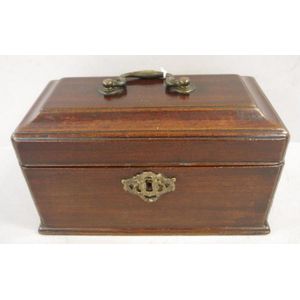George III Mahogany Tea Caddy with Brass Handles
You must be a subscriber, and be logged in to view price and dealer details.
Subscribe Now to view actual auction price for this item
When you subscribe, you have the option of setting the currency in which to display prices to $Au, $US, $NZ or Stg.
- Oak - Native to Europe and England, oak has been used for joinery, furniture and building since the beginning of the medieval civilisation. It is a pale yellow in colour when freshly cut and darkens with age to a mid brown colour.
Oak as a furniture timber was superceded by walnut in the 17th century, and in the 18th century by mahogany,
Semi-fossilised bog oak is black in colour, and is found in peat bogs where the trees have fallen and been preserved from decay by the bog. It is used for jewellery and small carved trinkets.
Pollard oak is taken from an oak that has been regularly pollarded, that is the upper branches have been removed at the top of the trunk, result that new branches would appear, and over time the top would become ball-like. . When harvested and sawn, the timber displays a continuous surface of knotty circles. The timber was scarce and expensive and was used in more expensive pieces of furniture in the Regency and Victorian periods. - George Iii - George III (1738 - 1820) was King of Great Britain and Ireland from 1760 to 1820.
- Mahogany - Mahogany is a dense, close grained red-coloured timber from the West Indies and Central America. It was first imported into Europe in the the early 18th century and its use continued through the 19th century. It was popular for furniture making because of its strength, the wide boards available, the distinctive grain on some boards, termed flame mahogany and the rich warm colour of the timber when it was polished.. The "flame" was produced where a limb grew out from the trunk of the tree, and this timber was usually sliced into veneers for feature panels on doors, backs and cornices.
Some terms used to describe mahogany relate to the country from which it originally came, such as "Cuban" mahogany, "Honduras" mahogany etc. However unless the wood has been tested the names assigned are more a selling feature, rather than a true indication of the timber's origin.
This item has been included into following indexes:
-
tea caddies, material
- mahogany 191
- pollard oak 16
- tea caddies, period or age - Georgian 320
Visually similar items

Georgian mahogany tea caddy, with brass fittings, width 22 cm, diameter 13 cm approx

A Regency period, rosewood and brass inlay sarcophagus shape, tea caddy, c.1820-1830, with two pullout canister boxes and central cut crystal mixing bowl. Height 19.2 cm. Length 30 cm. Depth 16 cm

Mid Georgian walnut tea caddy, with small bracket feet, brass escutcheon & handle & 3 section interier, 26 cm x 12.5 cm, 14 cm high approx.

An intriguing Anglo-Indian timber and brass jewellery box, late 19th century, with an arabesque decorated lid, brass edges and recessed bracket handles, the fine interior fitted with a series of drawers, removable trays, boxes, some inlaid, and fold out co
